Are you intrigued by the mysterious and misunderstood world of snakes? Whether you find them fascinating or a little frightening, there’s no denying that snakes are pretty cool creatures. We’re about to slither through some surprising facts about snakes and bust some myths that’ll make you see snakes in a whole new light. So, hold on to your scales, and let’s dive into these interesting facts about snakes.
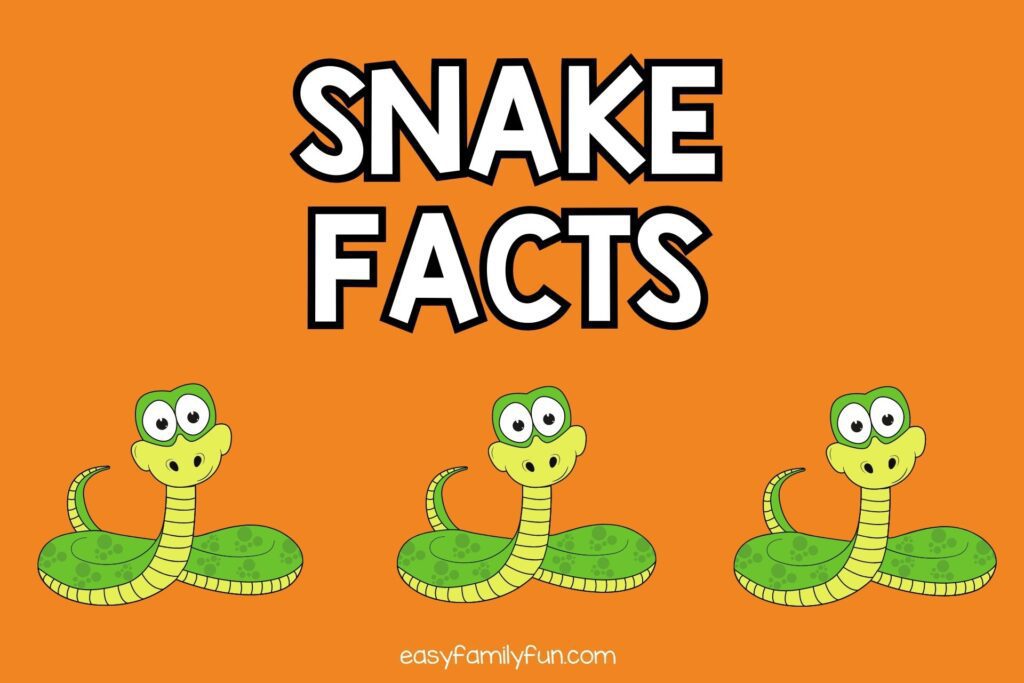
Did you know that snakes are one of the most adaptable species on Earth? Whether snakes live in the desert or the lush canopy of a tropical rainforest, snakes have figured out how to survive. Some snakes even know how to swim because they live in the water.
You might even wonder how snakes catch their prey without arms or legs. Did you know they have super flexible jaws that allow them to eat meals bigger than their heads? Imagine eating a whole Thanksgiving turkey in one bite; that’s basically what some snakes do! But don’t worry; for the most part, they are not interested in humans.
Another fun snake fact that most people don’t know is that not all snakes are venomous, and many of those that are usually use their venom to subdue prey rather than as a weapon against larger threats. You might say they’re more interested in self-defense than offense. Another fun fact is snake venom has actually given scientists ideas for new medicines.
Ready to unravel more snake facts and secrets? You’re in for an exciting journey as we delve deeper into the world of these incredible reptiles. Let’s shed our misconceptions and uncover the truly fascinating lives of snakes!
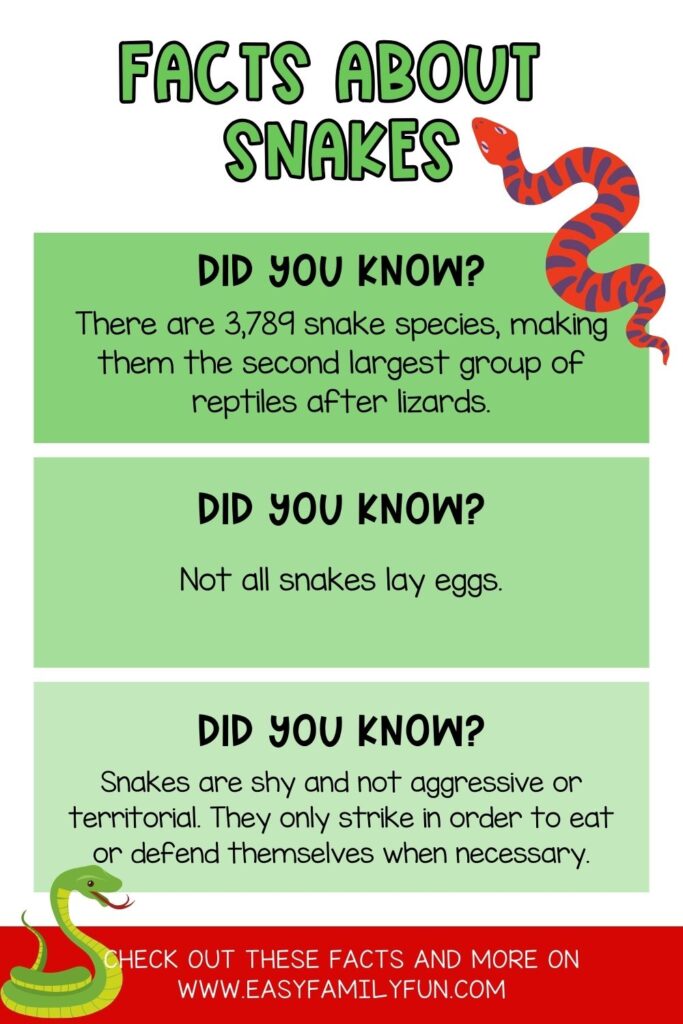
Facts about Snakes
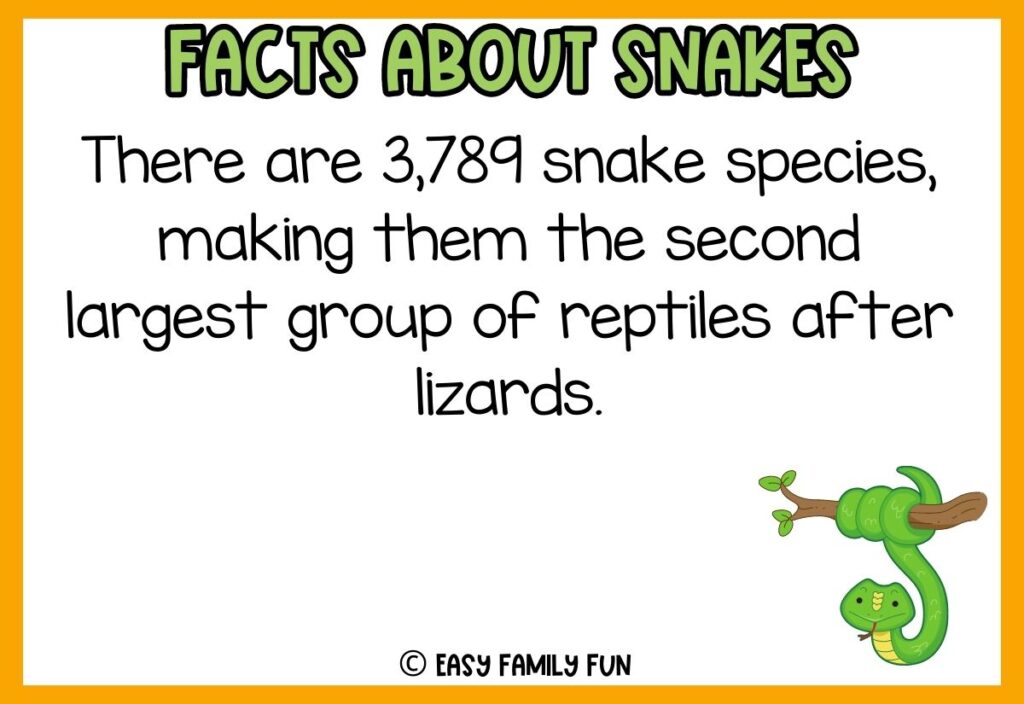
- There are 3,789 snake species, making them the second largest group of reptiles after lizards.
- Snakes evolved over 142 million years ago.
- Snakes are found everywhere except in Antarctica, Iceland, Ireland, Greenland, and New Zealand.
- Snakes use their tongues to smell.
- Snakes are a reptile.
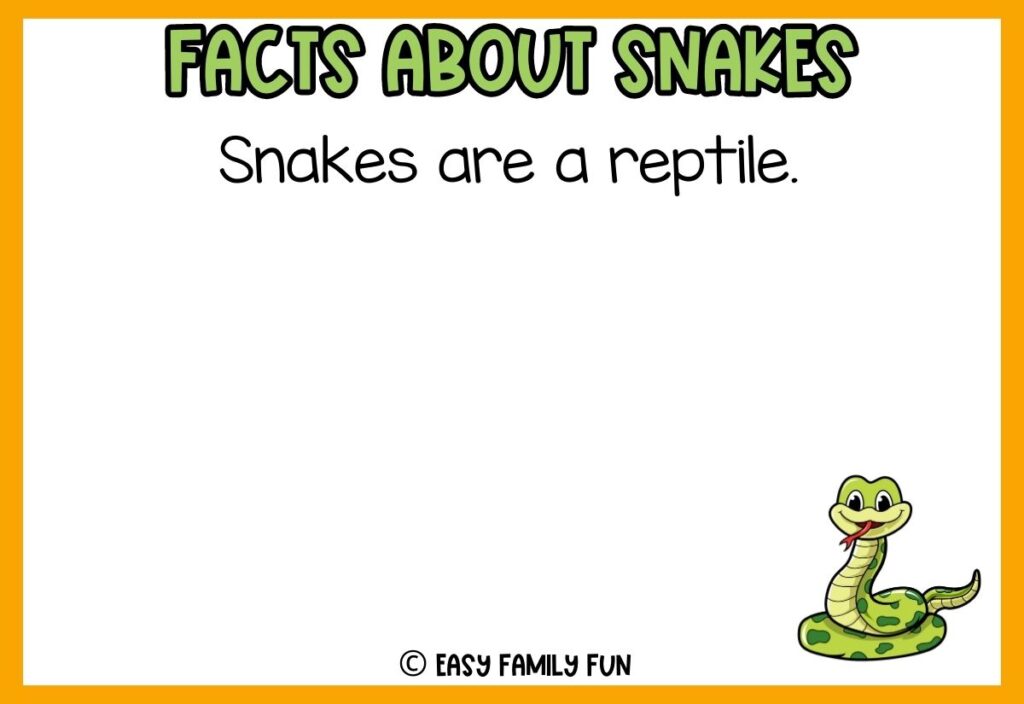
- The green anaconda is the heaviest snake, while the reticulated python is the longest.
- Snakes are carnivorous creatures, the eat the following: fish, amphibians, rodents, birds, worms, crustaceans, and even insects.
- About 600 snakes are venomous and only about 200—seven percent—are able to kill or significantly wound a human.
- Snakes have a limited amount of venom available at any given time.
- Not all snakes lay eggs.
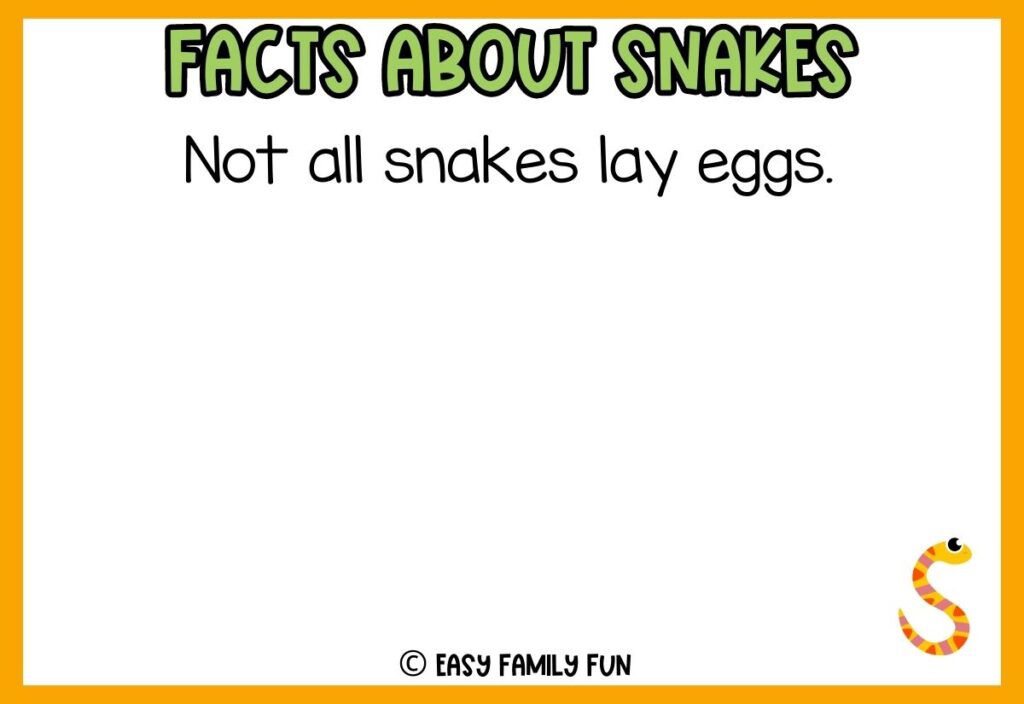
- Most snakes live on land.
- Almost all snakes are covered in scales and as reptiles, they’re cold-blooded and must regulate their body temperature externally.
- The venomous snakes to look out for are the black mamba, king cobra, inland taipan plus lots more.
- Australia has around 140 species of land snakes and around 32 species of sea snakes.
- Snake venom has a variety of different useful chemical compounds. Scientists are currently working with copperhead snakes and using their venom to create new cancer fighting drugs.
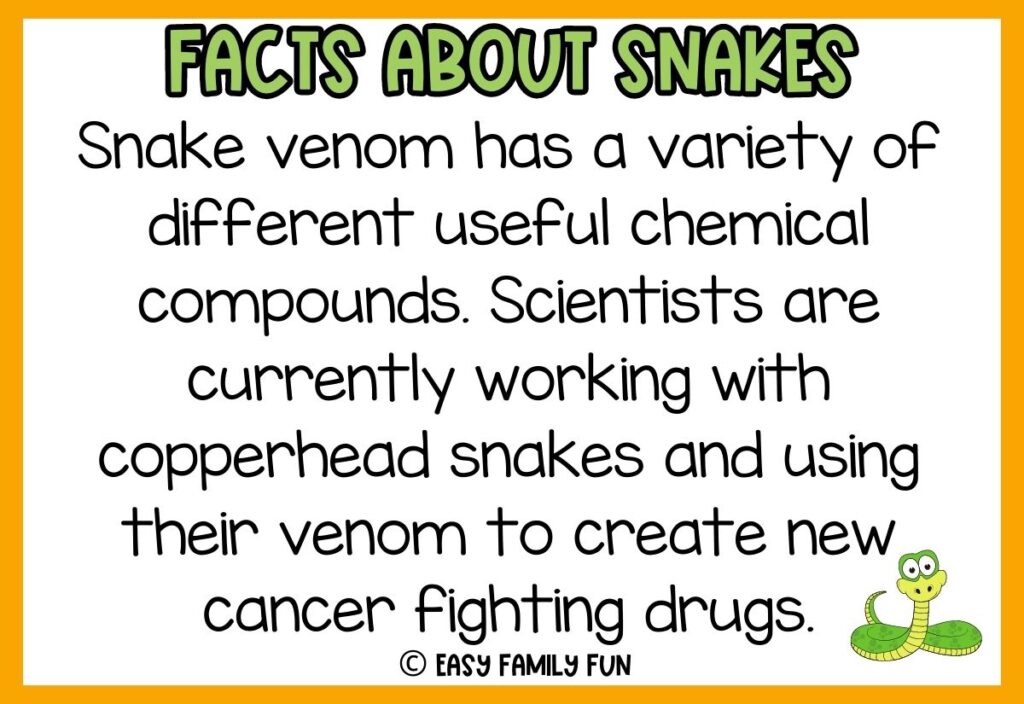
- Captive snakes can live up to 170 years, while wild snakes can reach 100 years.
- Snakes are shy and not aggressive or territorial. They only strike in order to eat or defend themselves when necessary.
- There are two types of snake venom – Hemotoxic venom attacks the blood, while neurotoxic venom targets the nervous system. Neurotoxic venom is considered much more dangerous.
- Snakes don’t have eyelids.
- There have been several species of snakes discovered that are mostly scaleless, but even those have scales on their bellies.
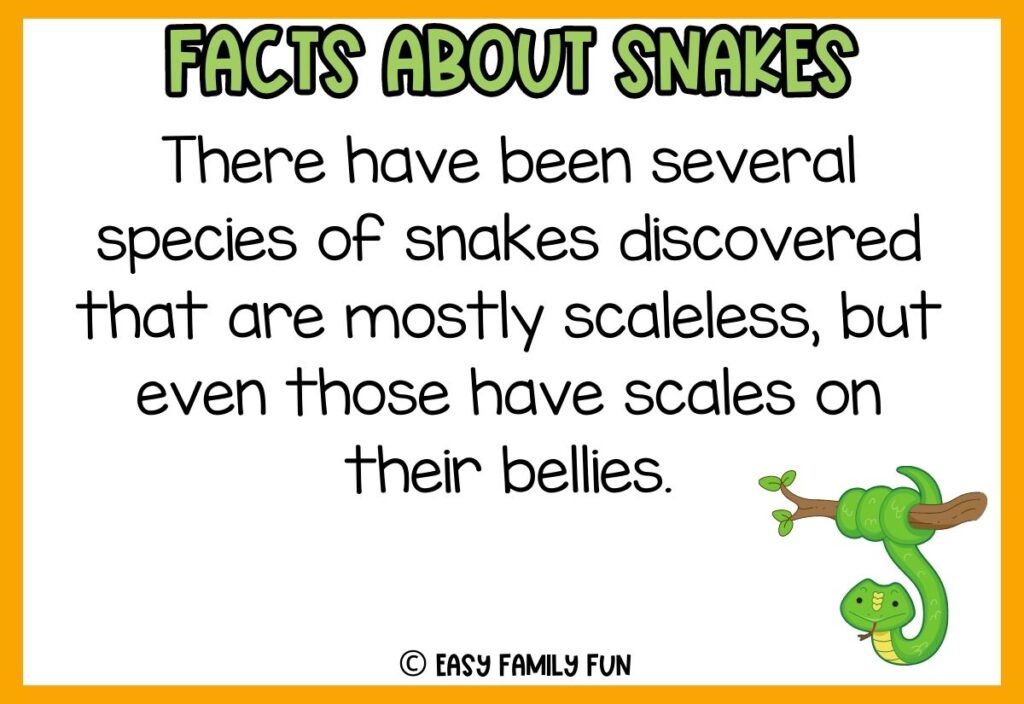
- Pit vipers, boa constrictors, and pythons can sense heat.
- Snakes do not hibernate but enter a state of reduced metabolic rate called BRUMATION during cooler weather periods.
- Venom is used to treat high blood pressure – Captopril was the first medicine approved by the FDA in 1988 to treat high blood pressure. It was made using the venom of the Brazilian Viper.
- The term snake comes from the Proto-Indo-European word *(s)nēg-o- which means “to crawl” or “to creep.”
- Ophidiophobia means intense fear of snakes.
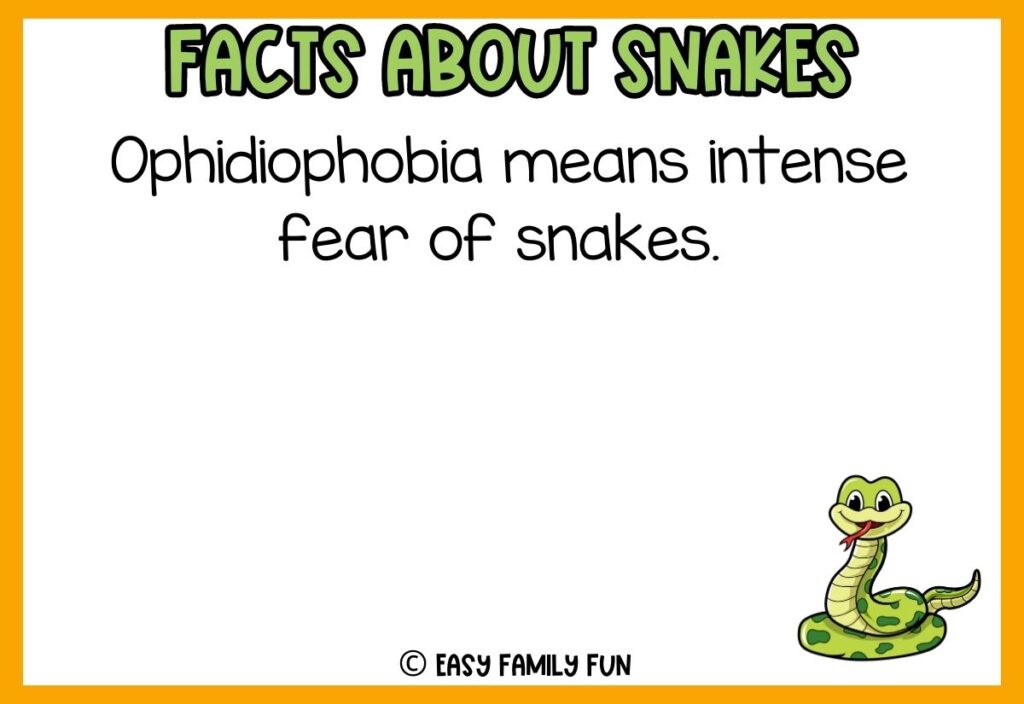
- Ophiology is the Study of Snakes.
- Snakes can move in a straight line. This is called rectilinear locomotion.
- Brightly-colored snakes are usually venomous, although some harmless species mimic them as a defense.
- The longest snake is the reticulated python.
- Some sea snakes can breathe partially through their skin, allowing them to stay underwater longer.
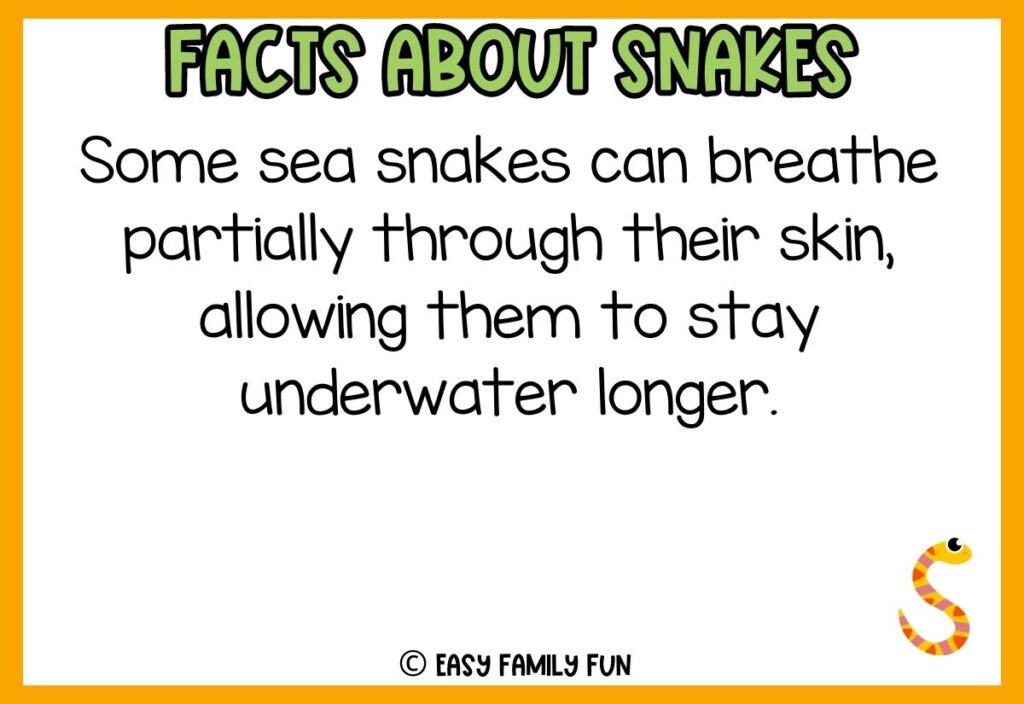
- Snakes are Ectotherms, which means that snakes rely on their environment to keep them warm and their bodies stable.
- About once a month snakes shed their skin, a process called ecdysis that makes room for growth and gets rid of parasites.
- Snakes hear using vibrations in their jaw bones.
- Snakes don’t have lymph nodes.
- Snakes have 5 forms of locomotion, these are rectilinear locomotion, sidewinding, concertina locomotion, serpentine Locomotion, and undulatory locomotion.
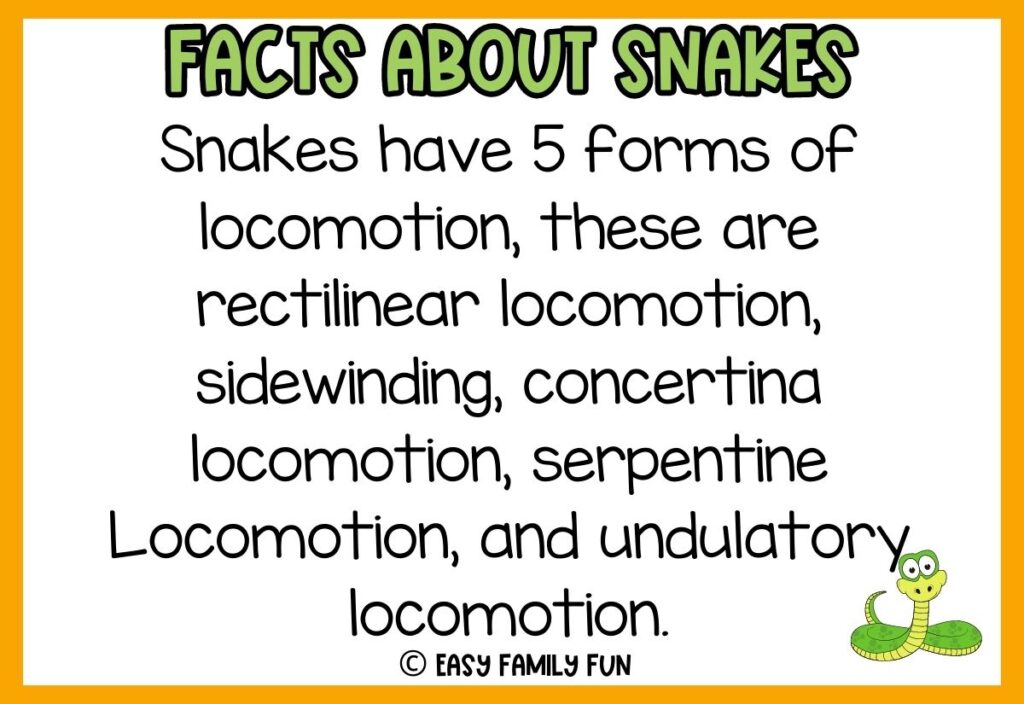
- The Barbados thread snake is the smallest snake species – This species is only around 3.94 inches (10 cm) long and the width of a spaghetti noodle.
- When a snake feeds, they unhinge their jaw to swallow prey whole.
- Snake scales (and rattlesnake rattles) contain keratin – the same substance found in human hair and nails.
- Snakes have flexible jaws so they can eat prey that are bigger than them. They then digest their prey with their strong stomach acid.
- Snake poop looks like bird droppings.
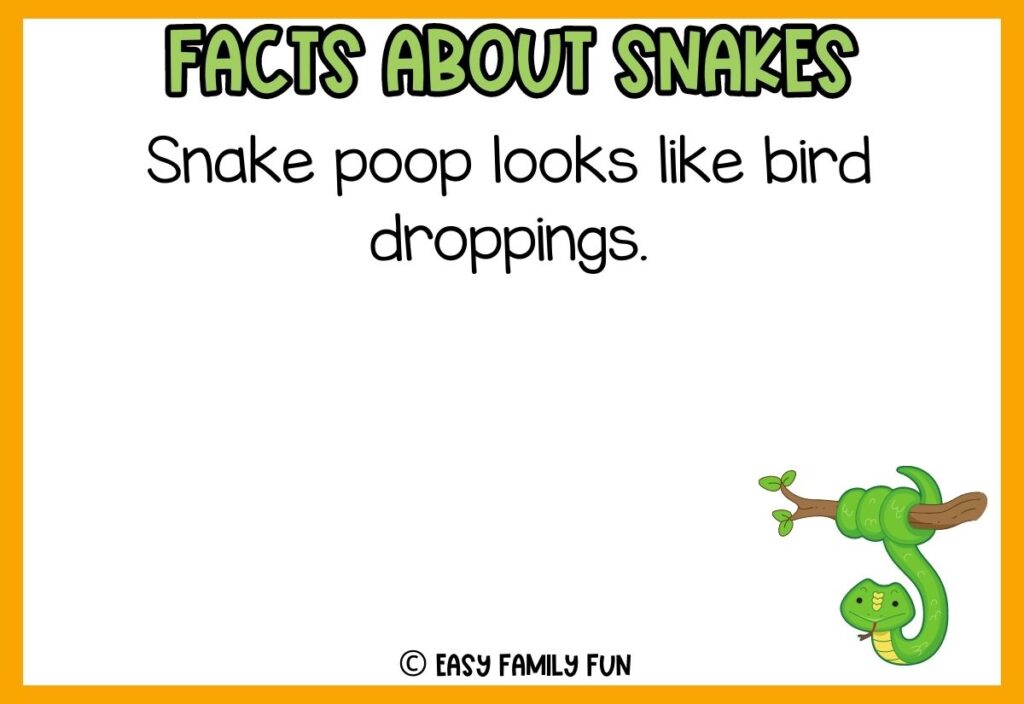
- Venomous snakes have special glands and teeth (fangs) designed to inject venom into their prey. Venom – is a highly modified saliva, it immobilizes prey and also aids in digestion by breaking down food.
- Snakes shed their skin between 4 and 12 times a year.
- Hognose snakes have a unique defensive behavior called death feigning. When they are threatened they will roll over onto their backs, release a foul odor, stick out their tongues and pretend to be dead!
- Snakes can digest everything but hair, claws, and feathers.
- Snakes don’t have great eyesight. Most snake species don’t have color vision.

- Snakes only eat 6-30 meals a year.
- The Titanoboa was the biggest snake fossil ever found. The horned viper’s unique horns above its eyes help camouflage it in its environment.
- Out of 725 venomous species, only 250 can kill a human.
- The decapitated snakehead is still able to bite and inject venom.
- Snakes are crucial predators that help control rodent populations.
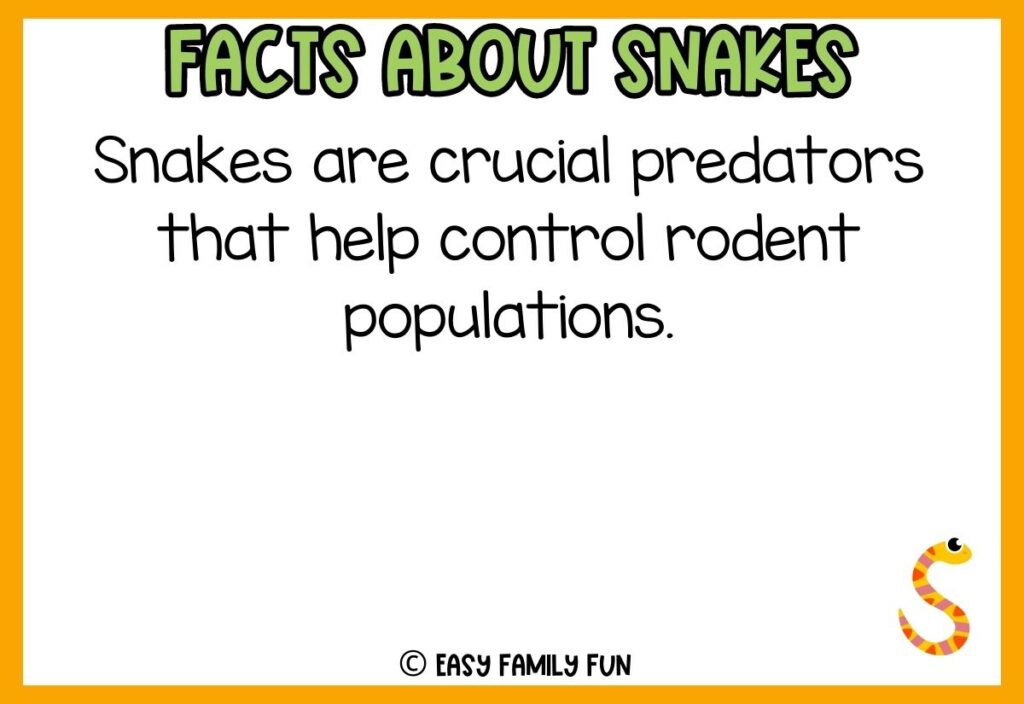
- The spitting cobra can eject venom with accuracy up to 9 feet away.
- The keelback snake has specialized glands in its neck that release a foul-smelling substance as a defense.
- Snakes only have one lung.
- The fastest snake can travel up to 12 miles per hour.
- Snakes are known to be able to jump from object to object.
- A snake skeleton has 600-1800 bones, depending on the species.
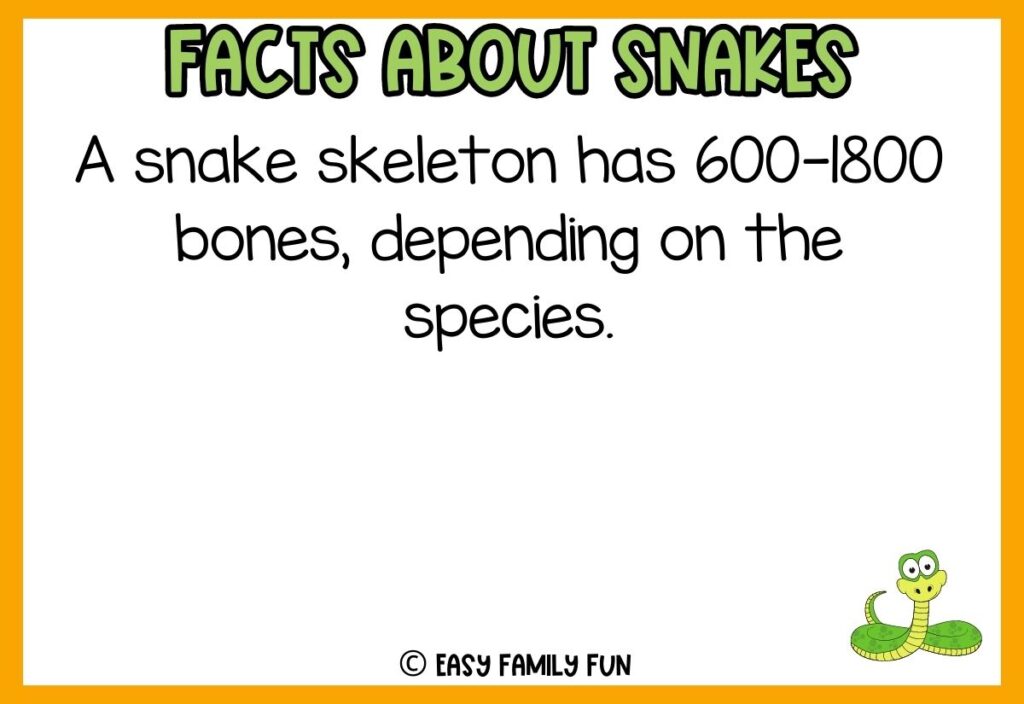
Did you know even more fascinating facts about Snakes? Share them in the comments so we can learn, too!
Are you looking for more fun and engaging facts to share with your family? Check out these other posts for more facts!
- 100 Fascinating Facts about Mexico
- 75 Fascinating Facts About France
- 100 Purr-fectly Delightful Facts About Cats
- 87 Fascinating Facts About Owls
- 103 Super Cool Facts About Space
- 100 Interesting Facts About Hurricanes
- Facts About the 9/11 Memorial
- Facts About Spring
- Facts About Rosa Parks
- 50 Fascinating Facts About Butterflies
- 50 Fascinating Facts About Eagles
- Facts About Rome
- Facts About Lions
- Facts about Big Ben
- 100 Best Facts About Quartz for Kids
- 100 Best Facts About Cheese For Kids
- 100 Best Facts About Canada for Kids
- 100+ Out-of-This-World Facts about Earth
- 100 Epic Bug Facts for Kids
- 100 Weird Facts About Animals for Kids
- 85 Stellar Facts About Jupiter
- 135 Fascinating Facts About Ireland That Will Make You Fall in Love
- 50+ Interesting Facts about the Nervous System [Fact Cards]
- 55 Interesting Facts About Seattle [Free Fact Cards]
- 55 Best Facts about Frogs [Free Fact Cards]
- 66 Best Facts About Blueberries [Free Fact Cards]
- 37 Best Facts About Bacon [Free Fact Cards]
- 65 Best Facts About Comets [Free Fact Cards]
- 85+ Best Titanic Facts [Free Fact Cards]
- Interesting Facts about Ladybugs [Free Fact Cards]
- Abraham Lincoln Facts You Should Know [Free Fact Cards]
- Dive Into These Facts About Jellyfish [Free Fact Cards]
- Interesting Banana facts [Free Fact Cards]
- 20 Interesting Facts About Red Wolves [Free Fact Cards]
- Mt. Rushmore Facts: Carving History in Stone [Free Fact Cards]
- 66 Best Facts About Blueberries [Free Fact Cards]
- Over 100 Fun Facts about North Carolina [Free Fact Cards]
- 79 Electrifying Facts about Lightning [Free Fact Cards]
- 56 Interesting Facts About Snakes [Free Fact Cards]
- 56 Interesting Facts About Snakes [Free Fact Cards]
- 53 Fascinating Facts about Spiders [Free Fact Cards]
- 74 Interesting Facts About New Zealand [Free Fact Cards]
- 50 Interesting Facts About Apples [Free Fact Cards]
- 100 Purr-fectly Delightful Facts About Cats
- Buzzing with Knowledge: Explore 65 Fascinating Facts About Bees!
- 100 Marvelous Facts About Monkeys
- Gallop Through Knowledge: With These 75 Fascinating Facts about Horses
- Travel Back in Time With These Facts About the 13 Colonies!
- 52 Facts About Neptune for the Future Astronauts in Your Family
- 40 Incredible Facts About Your Heart
- 25 Remarkable Facts about James Madison
- 35 Oink-some Facts About Pigs
- 50 Neck-Stretching Facts about Giraffes
- 65 Patriotic Facts about the Statue of Liberty
- 50 Incredible Facts About Turtles
- 40 Mischievous Facts About Raccoons
- 135 Fascinating Facts About Ireland That Will Make You Fall in Love
- 85 Stellar Facts About Jupiter
- 100 Weird Facts About Animals for Kids
- 100 Epic Bug Facts for Kids
- 100+ Out-of-This-World Facts about Earth
- 100 Best Facts About Canada for Kids
- 100 Best Facts About Cheese For Kids
How Do I Print A PDF?
You’ll need a program that supports PDFs. Adobe Acrobat is a great option. Open the program, click file, then print. Select your printer and the number of copies you want to print. Be sure you click double-sided if you want it to print on both sides.
Can I Resell These?
You may not resell any printable that you find on our website or in our resource library. You may use them for class parties, at church, at home, or in the classroom. You may get these printed at an office supply store or copy center at your own expense.
